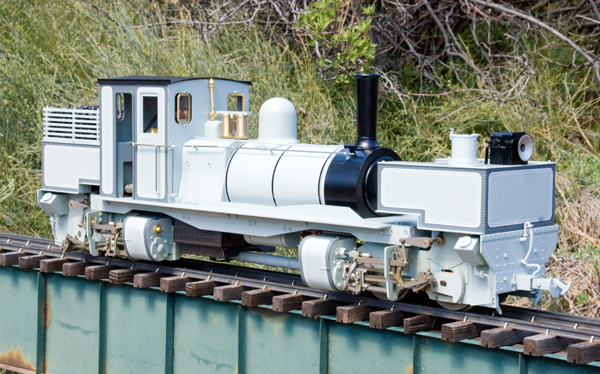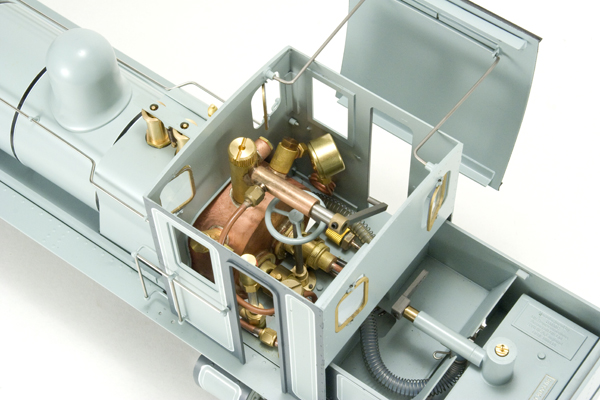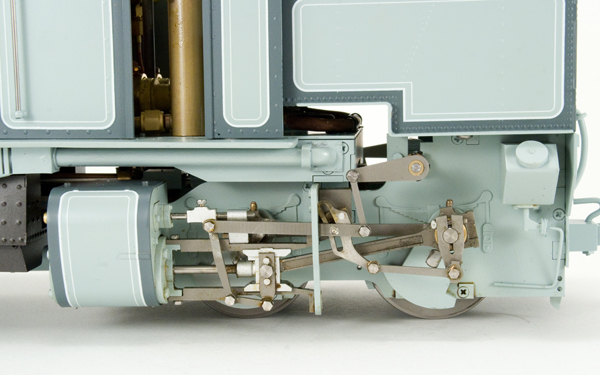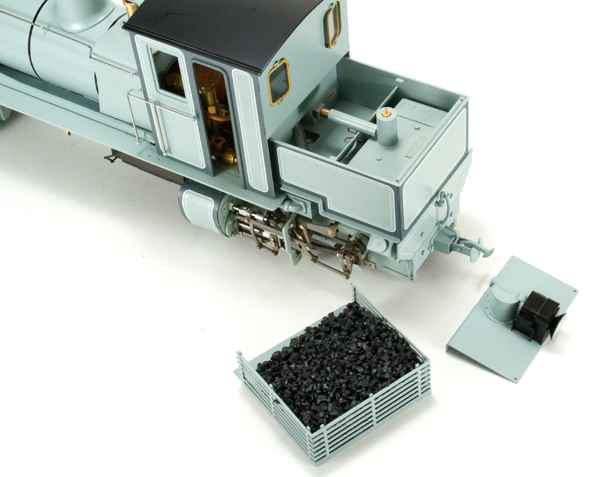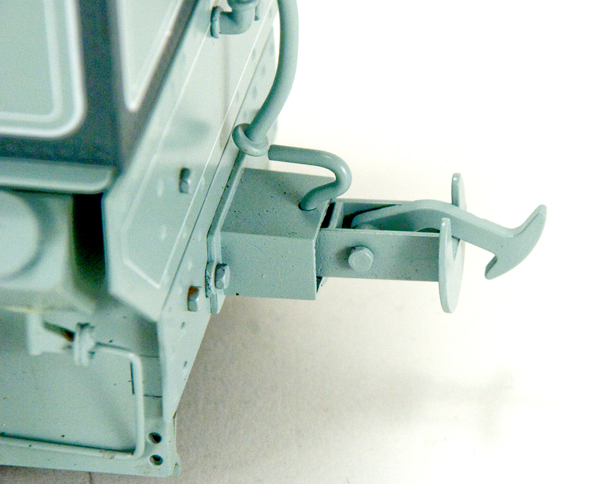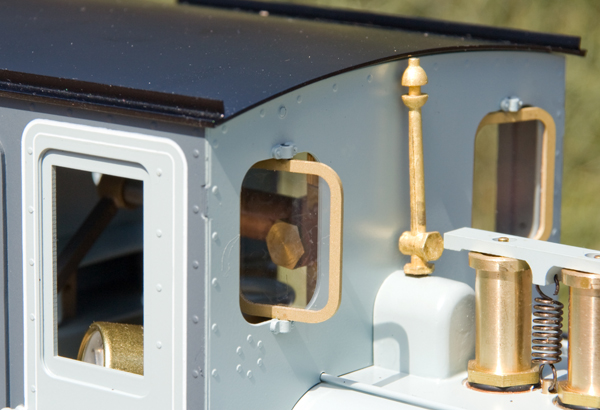Accucraft Trains
33260 Central Ave.
Union City CA 94587
Price: $4,250
Website: www.accucraft.com
1:19 scale, Tasmanian K1 Garratt; all metal construction; regaugeable; gas fired twin-flue boiler; pressure gauge, water glass, twin safety valves, throttle, filler plug; displacement lubricator; gas tank in rear bunker; dummy coal load; dummy Walschaerts valve gear reversed from the cab; four D-valve cylinders; articulated front and rear bogies; chopper couplers; steps and builder’s plates supplied separately. Dimensions: Length, 20 1/4″ over end beams; width, 4 3/4″; height over stack, 7″. In 1:19 scale, this works out to 32’1″ x 7’6″ x 11’1″, respectively.
Pros: Beautiful locomotive; excellent paint and graphics; high-quality construction; standard tool kit supplied; lubricator drain; regaugeable (ga. 0 or 1); insulated wheels; Goodall-type filler valve included; good level of detail; accurate model of the prototype
Cons: Reverser a little awkward; access to gas filler confusing (see below); difficulty in keeping pressure up; throttle could be a little more sensitive
Beyer-Garratt engines are unusual in the steam-locomotive world in that they have a large boiler slung between two articulated steam motors. The arrangement gives the relatively large engines flexibility and agility, enabling them to operated over rough trackage and around tight curves. Also, on curves, the boiler (and hence the center of gravity) shifts toward the center point of the curve, making these engines more stable going around bends.
Like all of Accucraft’s higher-end models, this one comes securely packed. You should allow 30-45 minutes just for unpacking the engine. Our review sample came in a large cardboard box. Inside, surrounded by foam, was a wooden box with a sliding lid. Inside that was the standard tool kit, a pair of white cotton driving gloves, and the locomotive. The engine, wrapped in tissue with an outer layer of plastic, was firmly taped to a plywood baseboard. This, in turn, was fastened to the bottom of the box with screws and nuts. I undid all of the nuts to release the engine, then carefully cut away the tape to finally free it. There was no owner’s manual in the box but I found one on Accucraft’s website.
Our review sample was provided in “works gray.” At the factory, prototype locomotives were often painted gray, lined out in black, for the official works photograph. The engine was then repainted in its standard road livery. Many people, myself included, find the works-gray livery to be quite attractive. The engine is also available in black, lined out in red and white. The paint and lining on the model was well up to Accucraft’s high standard. The detail level on this model is also quite good. There are some nice touches, like cab windows that open by pivoting on center trunnions. Cab steps are provided but must be screwed in by the purchaser.
This model is built to 1:19 scale, or 16mm to the foot. Being a two-foot-gauge prototype, this is the correct scale for running on 32mm-gauge track (0 gauge). The engine is easily regaugeable to gauge 1, though. The axles are dimpled to receive the set screws on the wheels, so you shouldn’t even need a wheel gauge to accurately regauge them. The necessary Allen key is provided.
The engine is fitted with a large, twin-flue boiler. It is gas fired and the gas tank is carried in the bunker behind the cab. As supplied there is a sort of half cover over the bunker. The gas valve is accessible in the front (open) half of the bunker and there is a plate with a dummy headlamp covering the back half. This also concealed the filler valve. I was a little befuddled as to how to access the filler valve, as the plate was screwed down and did not lift off, nor did the lid to the dummy hatch above the valve. I finally unscrewed the two screws holding the plate in place, which revealed the valve. Why the plate was actually screwed on is a mystery, as an operator would not want to unscrew it every time gas had to be added. Once it was unscrewed, I found that it sat securely in place without screws, so they were retired. Also supplied is a dummy coal bunker that fits in the space. This also covers the gas-valve handle. On our review sample, the gas-valve handle would foul the coal bunker when it was in place. This was an easy fix, though; I just loosened the handle and rotated it 180°.
Boiler fittings include two safety valves set at 60 psi, a water glass, a pressure gauge, and a throttle. The boiler can be filled through a plug atop the backhead. A Goodall-type filler valve is also included, which can replace the plug. This allows the boiler to be refilled while under pressure. A displacement lubricator in the cab, on the left side, has a drain that is fairly far removed from it, under the mid point of the boiler on the left side. To drain it, it helps if there is a little pressure left in the boiler.
The locomotive has four working D-valve cylinders with dummy Walschaerts valve gear. The reversing gear is actuated by a large wheel mounted on a vertical post in the cab, under the throttle. This operates the valve gear on both steam motors simultaneously via a system of shafts, gears, and U-joints. The wheel is a little awkward to get to, especially when all of the fittings around it are hot, but it’s not too bad. However, because of this arrangement, reversing cannot be easily radio controlled. The throttle, however, can be servo-actuated, and a separate throttle-control arm is included for that purpose.
The engine, despite its complexity, is fairly straightforward to operate. I oiled it all around, and filled the large lubricator with steam oil and the gas tank with butane. I filled the boiler with distilled water to about two-thirds of the glass. Opening the smokebox door, I turned on the gas and struck a match. The fire lit off easily and flashed back to both burners.
The ambient temperature was in the 50s. Pressure came up in seven or eight minutes. I opened the throttle and, after the usual sputtering and stuttering at the beginning of a run, the engine moved smoothly off. Control was good and slow-speed operation was excellent. The throttle, if anything, was not sensitive enough. I had to adjust it to get a little more throw out of it. Even then, top speed was quite realistic. I had a little trouble keeping the pressure up during the run, even after turning the gas up some. I would hope that this would remedy itself as the engine wears in and resistance in the moving parts becomes less over time. However, I have heard from others about similar problems with this engine.
The engine operated smoothly in both directions. For the review, the engine was run light. With four working cylinders, and given its weight, it should be capable of hauling just about anything you could put behind it. The run lasted around half an hour, with gas and water expiring about the same time. Water could be replenished at any time using the provided Goodall-type valve. The fire must be extinguished for the addition of more butane, then relit.
This is a beautiful model of an unusual locomotive. Most problems encountered in its operation were easily set right and it should provide years of good service.





